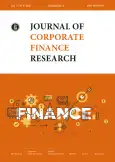Do Mergers and Acquisitions Promote R&D? The Case of European Innovation and Technology sector
- Authors: Rogova E.1, Kirichenko M.1, Lebedeva D.1
-
Affiliations:
- Санкт-Петербургский государственный университет
- Issue: Vol 17, No 4 (2023)
- Pages: 5-18
- Section: New Research
- URL: https://journal-vniispk.ru/2073-0438/article/view/302517
- DOI: https://doi.org/10.17323/j.jcfr.2073-0438.17.4.2023.5-18
- ID: 302517
Cite item
Full Text
Abstract
Innovation efforts and R&D play a foundational role for companies seeking to further develop their products and services and secure a sufficient market share. This is especially relevant for knowledge-intensive fields, particularly for the Innovation and Technology Sector, where players are constantly challenged with adapting to its multi-faceted nature, processing large amounts of data, and rapid innovation transfer. Thus, it is important to study the factors that contribute to R&D intensity and encourage innovations in detail. The study explores the impact of M&A activity on R&D intensity and R&D spending increase of both the acquiring companies and their targets in European Union. The final sample consists of 85 companies that had implemented M&A deals in the Innovation and Technology sector of the EU between 2007 and 2021, acting as acquirers or targets in these deals. The data is collected from Refinitiv Eikon database. Subgroups are determined based on categorization established by the European Commission. These include Business support service activities, Computer programming, Data processing, Manufacturing, and Telecommunications. In addition, financial data was collected on non-merging companies for forming a control group for the analysis. Difference-in-difference and probit model estimation methods are used to analyze the effect of M&A activity on the companies involved. The results show that the R&D intensity of both acquirers and targets decreases in the post-merger period. As for R&D expenditures, they increase for acquiring companies, while the effect is the opposite for their targets. The study contributes to the literature as it, unlike other similar studies that focus mostly on one group of actors, differentiates between the effect on the innovation activity of targets and the effect on the acquirers. The results could be used to increase the knowledge of the M&A effect on innovation efforts in the Innovation and Technology sector in European countries and understanding the possible problems it could lead to.
About the authors
E. Rogova
Санкт-Петербургский государственный университет
Author for correspondence.
Email: erogova@hse.ru
M. Kirichenko
Email: kirichenko.m.o@gmail.com
D. Lebedeva
Email: dlebedeva27@gmail.com
References
- Pitchbook Global M&A Report Q3 2023. 2023. URL: https://pitchbook.com/news/reports/q32-2023-global-ma-report (accessed on 03.07.2023)
- Haucap J., Rasch A., Stiebale J. How mergers affect innovation: Theory and evidence. International Journal of Industrial Organization. 2019;63:283-325. https://doi.org/10.1016/j.ijindorg.2018.10.003 DOI: https://doi.org/10.1016/j.ijindorg.2018.10.003
- Tyagi K. Promoting Competition in Innovation Through Merger Control in the ICT Sector: A Comparative and Interdisciplinary Study. Springer; 2019. 360 p. DOI: https://doi.org/10.1007/978-3-662-58784-3
- Gautier A., Lamesch J. Mergers in the digital economy. Information Economics and Policy, 2021;54:100890. https://doi.org/10.1016/j.infoecopol.2020.100890 DOI: https://doi.org/10.1016/j.infoecopol.2020.100890
- Argentesi E., Buccirossi P., Calvano E., et al. Merger policy in digital markets: An ex-post assessment. Journal of Competition Law and Economics. 2021;17(1):95-140. https://doi.org/10.1093/joclec/nhaa020 DOI: https://doi.org/10.1093/joclec/nhaa020
- Christofi M., Vrontis D., Thrassou A., et al. Triggering technological innovation through cross-border mergers and acquisitions: A micro-foundational perspective. Technological Forecasting and Social Change. 2019;146:148-166. https://doi.org/10.1016/j.techfore.2019.05.026 DOI: https://doi.org/10.1016/j.techfore.2019.05.026
- Kern B. R., Dewenter R., Kerber, W. Empirical Analysis of the Assessment of Innovation Effects in U.S. Merger Cases. Journal of Industry, Competition and Trade. 2016;16:373-402. https://doi.org/10.1007/s10842-016-0225-0 DOI: https://doi.org/10.1007/s10842-016-0225-0
- Cefis E., Marsili O. Crossing the innovation threshold through mergers and acquisitions. Research Policy. 2015;44(3):698-710. https://doi.org/10.1016/j.respol.2014.10.010 DOI: https://doi.org/10.1016/j.respol.2014.10.010
- Szücs F. M&A and R&D: Asymmetric Effects on acquirers and targets. Research Policy. 2014;43(7):1264-1273. https://doi.org/10.1016/j.respol.2014.03.007 DOI: https://doi.org/10.1016/j.respol.2014.03.007
- Motta M., Peitz M. Big tech mergers. Information Economics and Policy. 2021;54:100868. https://doi.org/10.1016/j.infoecopol.2020.100868 DOI: https://doi.org/10.1016/j.infoecopol.2020.100868
- Park W.G., Sonenshine R. Impact of Horizontal Mergers on Research & Development and Patenting: Evidence from Merger Challenges in the U.S. Journal of Industry, Competition and Trade. 2012;12(1):143-167. https://doi.org/10.1007/s10842-011-0119-0 DOI: https://doi.org/10.1007/s10842-011-0119-0
- Gopalakrishnan S., Damanpourb F. Patterns of generation and adoption of innovation in organizations: Contingency models of innovation attributes. Journal of Engineering and technology management. 1994;11:95-116. https://doi.org/10.1016/0923-4748(94)90001-9 DOI: https://doi.org/10.1016/0923-4748(94)90001-9
- Subramanian A., Nilakanta S. Organizational Innovativeness: Exploring the Relationship Between Organizational Determinants of Innovation, Types of Innovations, and Measures of Organizational Performance. Omega. 1996;24(6):631-647. https://doi.org/10.1016/S0305-0483(96)00031-X DOI: https://doi.org/10.1016/S0305-0483(96)00031-X
- Tushman M.L., Anderson P. Technological discontinuities and organizational environments. Administrative Science Quarterly. 1986;31(3):439-465. https://doi.org/10.2307/2392832 DOI: https://doi.org/10.2307/2392832
- Rao V.R., Yu Y., Umashankar N. Anticipated vs. Actual Synergy in Merger Partner Selection and Post-Merger Innovation. Marketing Science. 2016;35(6):934–952. https://doi.org/10.1287/mksc.2016.0978 DOI: https://doi.org/10.1287/mksc.2016.0978
- Phillips G.M., Zhdanov A. R&D and the Incentives from Merger and Acquisition Activity. The Review of Financial Studies. 2013;26(1):34–78. https://doi.org/10.1093/rfs/hhs109 DOI: https://doi.org/10.1093/rfs/hhs109
- Entezarkheir M., Moshiri S. Innovation spillover and merger decisions. Empirical Economics. 2021;61(5):2419–2448. https://doi.org/10.1007/s00181-020-01973-6 DOI: https://doi.org/10.1007/s00181-020-01973-6
- Chou S.C., Chu Y.F. Innovations and earnings non‐synchronicity: evidence from industry M&A activities. Accounting & Finance. 2022;62(1):337–367. https://doi.org/10.1111/acfi.12792 DOI: https://doi.org/10.1111/acfi.12792
- Zhou K., Yan R., Liu Y. Vertical merger, R&D collaboration and innovation. The European Journal of Finance. 2019;25(14):1289–1308. https://doi.org/10.1080/1351847X.2019.1589551 DOI: https://doi.org/10.1080/1351847X.2019.1589551
- Global M&A Trends in Technology, Media & Telecommunications: 2023 Outlook. PWC, 2023. URL: https://www.pwc.com/gx/en/services/deals/trends/2023/telecommunications-media-technology.html
- The regional perspective. 2023 M&A report. BCG. October 26, 2023. URL: https://www.bcg.com/publications/2023/regional-perspective-on-m-and-a-market-trends
- Science, technology and innovation – Overview. Eurostat Statistical, European Commission, Luxembourg. URL: https://ec.europa.eu/eurostat/web/science-technology-innovation
- Desyllas P., Hughes A. Do high technology acquirers become more innovative? Research Policy. 2010; 39(8): 1105–1121. https://doi.org/10.1016/j.respol.2010.05.005 DOI: https://doi.org/10.1016/j.respol.2010.05.005
- Technology Industry Outlook. Deloitte, 2022. URL: https://www2.deloitte.com/us/en/pages/technology-media-and-telecommunications/articles/technology-industry-outlook.html (accessed on 03.07.2023)
- NACE Rev. 2. Statistical classification of economic activities in the European Community. Luxembourg: Office for Official Publications of the European Communities, 2013. URL: https://ec.europa.eu/eurostat/documents/3859598/5902521/KS-RA-07-015-EN.PDF (accessed on 03.07.2023)
- Ball L., Sheridan N. Does inflation targeting matter? In: The Inflation-Targeting Debate. In: Bernanke B.S., Woodford M., eds. The Inflation-Targeting Debate. University of Chicago Press; 2005:249-276. URL: http://www.nber.org/chapters/c9561 DOI: https://doi.org/10.7208/chicago/9780226044736.003.0007
- Goodman-Bacon A. Difference-in-differences with variation in treatment timing. Journal of Econometrics. 2021; 225(2): 254-277. https://doi.org/10.1016/j.jeconom.2021.03.014 DOI: https://doi.org/10.1016/j.jeconom.2021.03.014
Supplementary files










